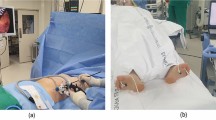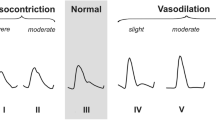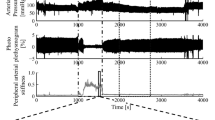Abstract
Blood flow monitoring systems such as photoplethysmogram (PPG) and laser Doppler flowmetry (LDF) are useful for intraoperative determination of a successful endoscopic thoracic sympathectomy (ETS) procedure, as they are able to indicate a sympatholytic response. A recently developed novel arterial mechanical impedance monitor has been shown able to provide a value for peripheral arterial stiffness, shown as K. In this retrospective cohort study, we compared the intensity of K with that of PPG and LDF during ETS procedures. Seventy-nine patients with hyperhidrosis underwent a surgical sympathectomy procedure under general anesthesia, during which they were managed by monitors attached to the tips of their fingers. Circulatory variables before and after the surgical procedure were recorded during ETS, then the ratios of those indices were statistically compared. With a statistical significance level of p < 0.05, K was shown to have a greater alteration as compared to PPG and LDF at the time of skin incision as well as neural clipping in both hands. We concluded that arterial mechanical impedance shown by K is a more sensitive monitor of sympathetic activity derived from vasoconstriction and vasodilation during an ETS procedure as compared to PPG and LDF.





Similar content being viewed by others
References
Drott, C., Gothberg, G., & Claes, G. (1995). Endoscopic transthoracic sympathectomy: An efficient and safe method for the treatment of hyperhidrosis. Journal of the American Academy of Dermatology, 33(1), 78–81.
Luginbuhl, M., Reichlin, F., Sigurdsson, G. H., Zbinden, A. M., & Petersen-Felix, S. (2002). Prediction of the haemodynamic response to tracheal intubation: Comparison of laser-Doppler skin vasomotor reflex and pulse wave reflex. British Journal of Anaesthesia, 89(3), 389–397.
Ginosar, Y., Weiniger, C. F., Meroz, Y., Kurz, V., Bdolah-Abram, T., Babchenko, A., et al. (2009). Pulse oximeter perfusion index as an early indicator of sympathectomy after epidural anesthesia. Acta Anaesthesiologica Scandinavica, 53(8), 1018–1026. doi:10.1111/j.1399-6576.2009.01968.x.
Kim, J. M., Arakawa, K., & VonLintel, T. (1975). Use of the pulse-wave monitor as a measurement of diagnostic sympathetic block and of surgical sympathectomy. Anesthesia and Analgesia, 54(3), 289–296.
Eisenach, J. H., Pike, T. L., Wick, D. E., Dietz, N. M., Fealey, R. D., Atkinson, J. L. D., et al. (2005). A comparison of peripheral skin blood flow and temperature during endoscopic thoracic sympathotomy. Anesthesia and Analgesia, 100(1), 269–276. doi:10.1213/01.ANE.0000139934.15659.7F.
Murray, W. B., & Foster, P. A. (1996). The peripheral pulse wave: information overlooked. Journal of Clinical Monitoring, 12(5), 365–377.
Nakamura, R., Saeki, N., Kutluk, A., Shiba, K., Tsuji, T., Hamada, H., et al. (2009). Arterial mechanical impedance is a sensitive stress response monitor during general anesthesia. Hiroshima Journal of Medical Sciences, 58(4), 75–82.
Kutluk, A., Tsuji, T., Ukawa, T., Nakamura, R., Saeki, N., Yoshizumi, M., et al. (2010). A novel online method to monitor autonomic nervous activity based on arterial wall impedance and heart rate variability. Medical & Biological Engineering & Computing, 48(4), 351–359. doi:10.1007/s11517-010-0580-7.
Hirano, H., Horiuchi, T., Kurita, Y., Ukawa, T., Nakamura, R., Saeki, N., Yoshizumi, M., Kawamoto, M., & Tsuji, T. (2013). Monitoring of peripheral vascular condition using a log-linearized arterial viscoelastic index during endoscopic thoracic sympathectomy. Conf Proc IEEE Eng Med Biol Soc, 2587–2590, doi:10.1109/EMBC.2013.6610069.
Bland, J. M., & Altman, D. G. (1995). Multiple significance tests: The Bonferroni method. BMJ, 310(6973), 170.
Author information
Authors and Affiliations
Corresponding author
Rights and permissions
About this article
Cite this article
Elbegzaya, S., Nakamura, R., Saeki, N. et al. Alteration of Arterial Mechanical Impedance Greater than that of Photoplethysmogram and Laser Doppler Flowmetry during Endoscopic Thoracic Sympathectomy. J. Med. Biol. Eng. 37, 820–825 (2017). https://doi.org/10.1007/s40846-017-0246-0
Received:
Accepted:
Published:
Issue Date:
DOI: https://doi.org/10.1007/s40846-017-0246-0




